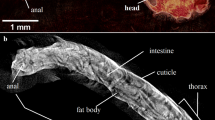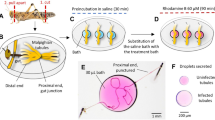Abstract
WATER conservation is critical for insects because of their large surface area relative to volume and the generally arid environment in which they live. Their survival depends on the waterproofing mechanism of the cuticle and the control of excretory and respiratory mechanisms which lead to water loss. There are indications that the critical water balance is disrupted by poisoning with certain insecticide chemicals1–4, but the physiological basis for this action has not previously been defined. Treatment of Rhodnius with DDT results in the accumulation of a large volume of fluid in the rectum1. We have now established that paralytic doses of compounds, representing each of the major types of insecticide chemicals, initiate massive excretion of fluid into the rectum of Rhodnius. Furthermore, the underlying mechanism involves the release of diuretic hormone, possibly from a bound form in the central nervous system, into the haemolymph where it contacts the Malpighian tubules and greatly increases their rate of secretion.
This is a preview of subscription content, access via your institution
Access options
Subscribe to this journal
Receive 51 print issues and online access
$199.00 per year
only $3.90 per issue
Buy this article
- Purchase on Springer Link
- Instant access to full article PDF
Prices may be subject to local taxes which are calculated during checkout
Similar content being viewed by others
References
Spiller, D., thesis, Univ. Cambridge (1955).
Jochum, F., Höfchen-Briefe, 9, 289 (1956).
Roan, C. C., and Hopkins, T. L., Ann. Rev. Entomol., 6, 333 (1961).
Roberts, R. B., Miskus, R. P., Duckles, C. K., and Sakai, T. T., J. Agric. Food Chem., 17, 107 (1969).
Maddrell, S. H. P., J. Exp. Biol., 51, 71 (1969).
Maddrell, S. H. P., J. Exp. Biol., 41, 459 (1964).
Maddrell, S. H. P., J. Exp. Biol., 45, 499 (1966).
Berridge, M. J., and Patel, N. G., Science, 162, 462 (1968).
Colhoun, E. H., in Insects and Physiology (edit. by Beament, J. W. L., and Treherne, J. E.), 201 (Oliver and Boyd, London, 1967).
Alivisatos, S. G. A., Papaphilis, A. D., Ungar, F., and Seth, P. K., Nature, 226, 455 (1970).
Berridge, M. J., in Insects and Physiology (edit. by Beament, J. W. L., and Treherne, J. E.), 329 (Oliver and Boyd, London, 1967).
Author information
Authors and Affiliations
Rights and permissions
About this article
Cite this article
MADDRELL, S., CASIDA, J. Mechanism of Insecticide-induced Diuresis in Rhodnius. Nature 231, 55–56 (1971). https://doi.org/10.1038/231055a0
Received:
Issue Date:
DOI: https://doi.org/10.1038/231055a0
Comments
By submitting a comment you agree to abide by our Terms and Community Guidelines. If you find something abusive or that does not comply with our terms or guidelines please flag it as inappropriate.



